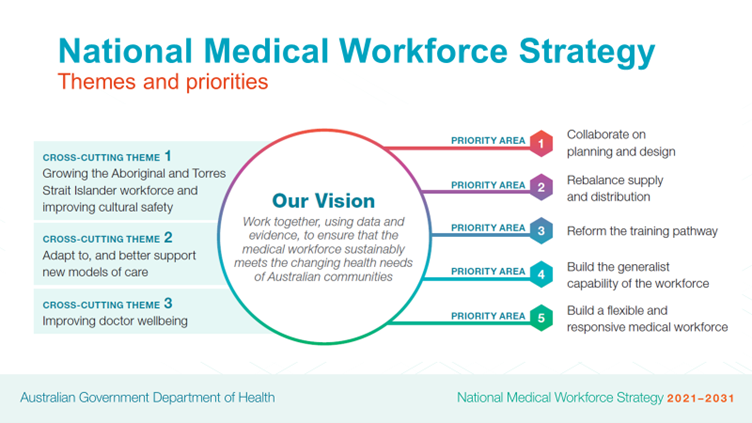WHAT number, skills and distribution of doctors are needed in Australia? How can health systems give doctors flexibility to have lives as well as work, and how can more Aboriginal and Torres Strait Islander doctors be encouraged into medical careers?
An approach to answering these questions has been agreed to by Australian health ministers, and has now been launched as the National Medical Workforce Strategy. The Strategy sets out how organisations that impact on the medical workforce will work together to provide Australians with access to medical services.
The Strategy is the result of two years’ work by Australian, state and territory governments, specialist medical colleges, medical peak bodies, regulators, and extensive consultations. The project started in recognition that, despite high-quality training systems and recent investment in increasing the number of medical graduates, Australians cannot access medical care equitably. Medical students and junior doctors study and work but without confidence that they will get into the medical specialty of their choice, and if they do, that there will be jobs once qualified. The COVID-19 pandemic has challenged many of the assumptions underpinning medical training and assessment, workforce sufficiency and mobility. Concern regarding high-profile cases and evidence of doctors’ high stress, long hours and career uncertainty provided further impetus on the need for system-wide change (here, and here).
Initial consultations identified the reasons for workforce issues, such as ongoing maldistribution of the medical workforce geographically and by medical specialty. The next phase analysed the system, professional and individual factors that drive these imbalances, with a focus on how these could be modified. Finally, a series of recommendations for action were suggested, prioritised and agreed.
The vision of the Strategy is to use data and evidence to ensure the medical workforce can sustainably meet the changing needs of Australian communities. This acknowledges the predicted changes to disease profiles with an ageing population and the need for flexibility and redundancy to handle unpredictability such as pandemics.

Actions will incorporate three overarching themes:
- improving the health care of Aboriginal and Torres Strait Islander Australians by growing the Aboriginal and Torres Strait Islander medical workforce, by working to provide more culturally safe environments for Aboriginal and Torres Strait Islander medical practitioners and patients;
- the development of an adaptable medical workforce, with the ability to respond to opportunities to develop and implement new, more effective models of care, particularly as new technology become available; and
- addressing doctor wellbeing.
Detailed recommendations are grouped into five priority areas.
Priority one recommends collating data from governments, hospitals, colleges and universities to model the demand and supply for medical specialties. A joint planning and advisory body will be established to use this data to recommend training numbers and the distribution of training places.
Priority two considers imbalances and has actions to improve the distribution of practitioners to regional and rural areas, and the role of locums. A framework for career “middle grade” doctors will be developed to contribute to job satisfaction, professional development, wellbeing and longer term sustainability for this key component of the medical workforce.
Priority three examines training pathways, regarding their structure and the experience for trainees, and how to create more regional and rural training opportunities.
Priority four looks at the challenges created by a growing subspecialist workforce, and the need to shift the balance to increased numbers working in general practice and other generalist specialist roles.
Priority five looks at opportunities for systems, structures and careers to be more flexible. For example, portability of benefits for doctors moving from hospital practice into general practice and between states, and more recognition of prior learning as doctors switch interests or specialties through their careers.
The Strategy highlights the need for longitudinal and synergistic action and collaboration between organisations. Clinicians, health services and educational organisations have adopted digital health, and used IT to maintain services, training and exams during COVID-19. The Strategy similarly provides a framework for learning how regulation, training and red-tape impacted the workforce’s ability to respond to COVID-19, the impact of COVID-19 on the workforce and the changes needed for a sustainable workforce in the future. This should result in improvements for patients, the health system and doctors.
Those who are interested to read more about the Strategy can access it at https://www.health.gov.au/initiatives-and-programs/national-medical-workforce-strategy-2021-2031.
Associate Professor Susan Wearne is Senior Medical Adviser in the Health Workforce Division, Department of Health, Canberra; she is a Clinical Associate Professor at Australian National University, and Chair of the National Medical Workforce Steering Committee.
Professor Jenny May AM is the Betty Fyffe Chair of Rural Health and Director in the University of Newcastle’s Department of Rural Health. She is also Conjoint Professor of Rural Medicine at the University of New England, and co-Chair of the National Medical Workforce Advisory Committee.
Acknowledgements: Thanks to Kathryn Yuile and Amy Fulham for helpful feedback on earlier drafts.
The statements or opinions expressed in this article reflect the views of the authors and do not represent the official policy of the AMA, the MJA or InSight+ unless so stated.

 more_vert
more_vert
Thank you A/Prof Wearne and Prof May for your fantastic work and for this piece which clearly communicates the strategy. It’s fantastic to see the it public after your hard work, and the contribution of many passionate stakeholders. AMSA has been so privileged to be part MWRAC and I am personally looking forward to working with the Department on the implementation of the strategy and ensuring there is adequate funding for fulfilling the priorities and goals of the strategy.